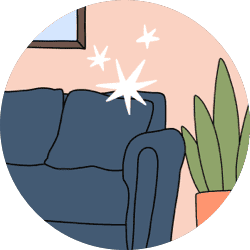Coping With Alzheimer's Symptoms: Visual Clutter
Environmental clutter with those battling Alzheimer's disease is an often-discussed topic. You can easily find many articles that focus on the safety issues, overstimulation, and mental health impacts caused by environmental clutter.
However, there is not a lot of discussion on how a cluttered environment can visually impact those living with Alzheimer's disease.
Decreased visual processing
It is widely known those living with Alzheimer's disease frequently experience difficulties with their ability to process what they see. In most cases, the person's vision is intact. However, the disease affects the brain's ability to process the information they are seeing.
Posterior cortical atrophy and vision issues
As Alzheimer's disease research continues to expand, we are learning more about the disease.
Posterior cortical atrophy (PCA) is a type of Alzheimer's disease that greatly impacts one's ability to process visual input. People with this type of Alzheimer's disease will have increased visual symptoms, which makes navigating their environment much more difficult.1

Clutter and Alzheimer's disease
Both of my parents had Alzheimer's disease. I have personally experienced walking into a home full of clutter – literally stuff everywhere. I can only imagine that this negatively affected their anxiety, concentration level, and safety.
But beyond all of that, let's talk about the visual clutter and the visual noise that clutter creates.
Visual noise and Alzheimer's disease
Visual noise is anything that may distort, transform, block, or add to what we see. In the home environment, this could mean the amount of furniture and stuff we have, the use of bright colors or patterns, and the amount of light in the room.2
People living with Alzheimer's disease already have a difficult time with their ability to process what they see visually. So, living in an environment that is full of visual noise could potentially make processing visual information even harder.

Tips for minimizing the "noise"
Honestly, I believe visual noise was a contributing factor to some of the difficulties my parents faced. Here are some tips I have learned through my experiences as a caretaker and occupational therapist.
Walls and floors in contrasting colors
Making the floors and walls different neutral colors helps to create contrast for our loved ones with Alzheimer's disease. This helps a person with visual processing issues to be able to function more independently.
Eliminate competing busy patterns
Remove or replace curtains and rugs that have busy patterns. Too many competing and busy patterns can increase confusion when dealing with visual processing issues. With my parents, I found that busy patterns caused a lot of stimulation. This can be hard for the brain to process.
Simplify
Decrease the amount of furniture, décor, and artwork. More stuff = more visual input that must be processed in the brain.
Limiting reflective surfaces
Decrease the number of mirrors in the home. In my experience, mirrors create more confusion. Sometimes our loved ones see their reflection. They process that there is a person present, but they cannot process that this person is them. So, sometimes decreasing the number of times they can see their reflection helps to decrease visual noise and overall confusion.
Adequate and ambient lighting
Too much light or not enough light in a room can create unnecessary visual noise. Nice ambient or softer lighting works well. This can be achieved by using table or floor lamps and wall lighting.
Reducing visual clutter
Understanding how visual clutter impacts the home environment and taking steps to mitigate it can help keep your loved one in the home safer and longer as they contend with Alzheimer's disease.
If any of you in our community have other tips in helping to decrease the visual noise in their homes, please reach out. I would love to hear them!

Join the conversation